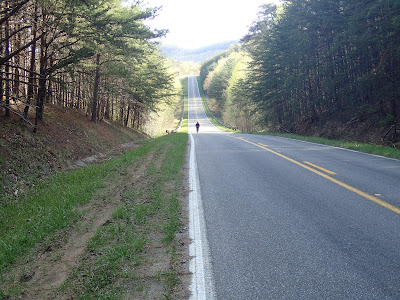Almost 200 people turned out — but you would have been able to predict that even before entering the building: Every available sign and stachion on the sidewalk had a bike locked to it.I don't want to dog our fair city and its efforts to increase bike facilities and usage, but I'm just simply struck by this observation. It seems like their attendance, about 200, is similar to our Bike Summit II. Their metro population, 850,000 (including some other local cities), is about the same as our own. But what is different is that there were not bikes coming our of the woodwork at our local meeting. Furthermore, the article states that the central premise of the meeting is to discuss the development of functional bike paths which will connect the city and will get people out of their cars. Our entire morning session was nothing more than an Ad campaign for a suburban park that you won't be able to get to without a car. I just have this sneaking suspicion that bike usage in Louisville is overwhelmingly recreational, as opposed to functional, and that many of our long-term goals (the 100-mile Louisville Loop) mirror this usage, as that of recreation and not as something transformational, like the bicycle as transportation. Just a thought.
Saturday, February 28, 2009
Why L'Ville is different
I remarked previously that it didn't seem like many people actually biked to the Bike Summit II. Roaming around tonight I found an article via Rocbike of Albany, NY and their first public meeting to discuss their new city bike plan. The author states,
Subscribe to:
Post Comments (Atom)
Alabama Sky Day 3 Vistas
We began Day 3 with a basic breakfast at the restaurant, again better than camp cooking a salt bomb,and bundled up for a long descent in th...

-
It's 1.15p.m. The fam is at various church-related activities and I now have time to ride. Por otro lado , afuera provides me 39F and ...
-
In keeping with the 2013 3rd annual CC, I'm now at 1/7. This past Sunday, after a brisk Saturday tempo ride, I rambled and ambled to Qui...
4 comments:
I think your sneaking suspicion is absolutely right. And from a monetary point of view, it makes total sense. Metro government wants to make more recreational trails, and more park trails, eventually developing places to host big events, which in theory would bring in more tax dollars. Getting more people to ride bikes as general transit means less spending on gasoline (and other maintenance) which means less tax dollars. It's lousy, but I wonder if that's the ultimate thinking behind the recreational push.
If the paths are designed correctly, they would be useful for both recreational and functional cyclists.
It may mean that the commuters only hit the path to get around bad traffic areas due to the recreational riders in the way, but that is probably the ideal situation.
I think the tax issue is short-sighted, as making Louisville more bike-friendly will increase property values near city center... which should help with property taxes.
Also, if the rate of automotive traffic growth slows, less money will need to be spent on upgrading and expanding roads.
Good points, Dave.
Tex, You asked for my input. I'll give you my opinion about bike paths and bike lanes. Keep in mind I'm still forming these opinions and also, I'm not familiar with the issues you are having in the 'ville. Up here, if I had my wish, education would be the first order of business. Educating both cyclists and motorists about the laws for bicycles. I would prefer a shared infrastructure so that bikes are seen as equals and having equal rights to the use of the roads. Here in Duluth, a population center that is not as dense as larger metro areas, I don't think I'm in favor of spending money on either bike paths or striped lanes. I don't want motorists to think bikes belong on paths or in specific lanes. I want to use the roadways the same way cars do.
Post a Comment